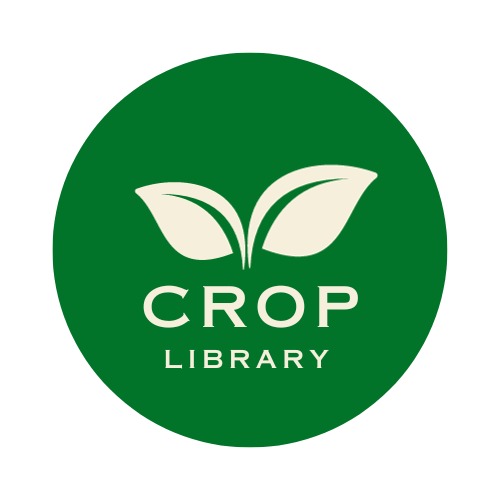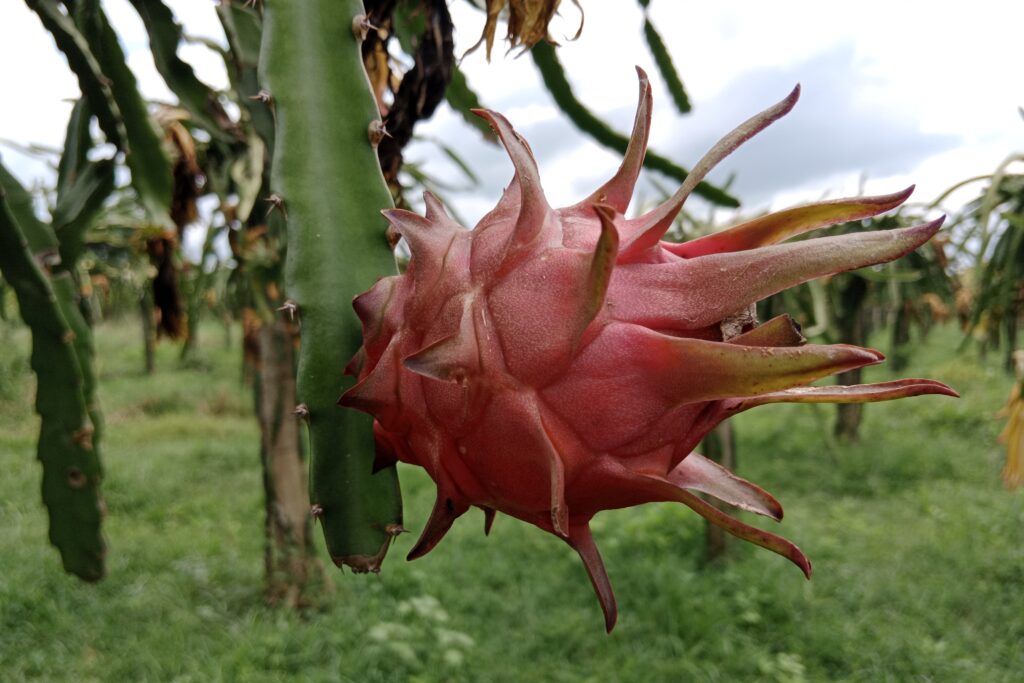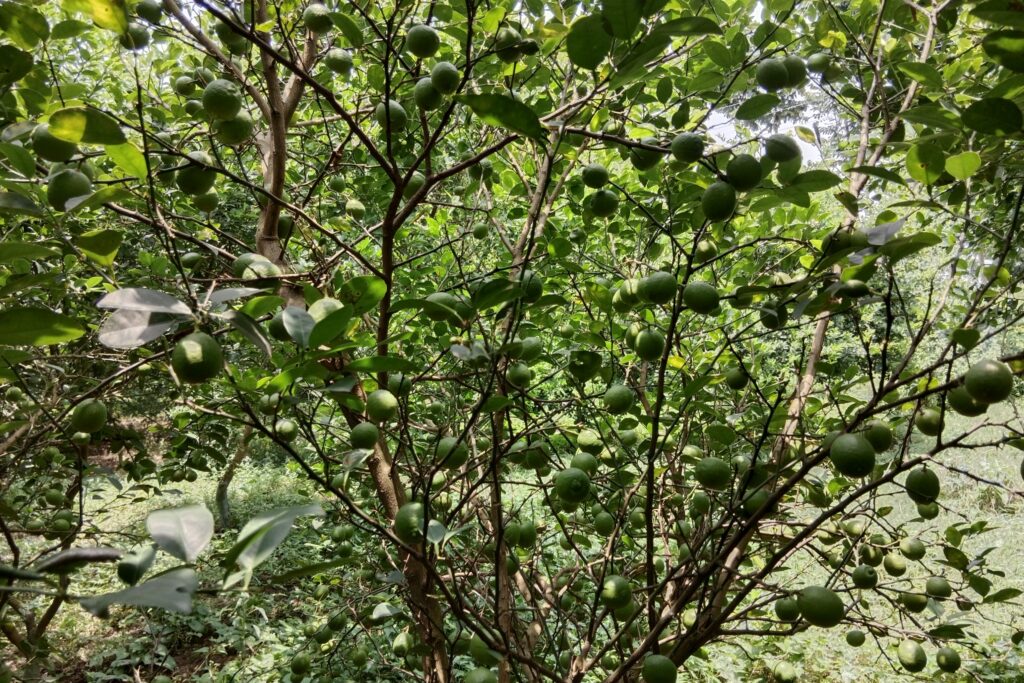Dill Leaf Farming
Dill (Anethum graveolens) is a fragrant annual plant grown for both its leafy greens and seeds. The delicate leaves, often called dill weed, are widely used to add flavor in various European, Scandinavian, and Middle Eastern dishes, while the seeds serve as a spice ingredient. When cultivated for leaf production, farmers adopt methods that stimulate abundant vegetative growth instead of allowing the plant to mature and produce seeds.
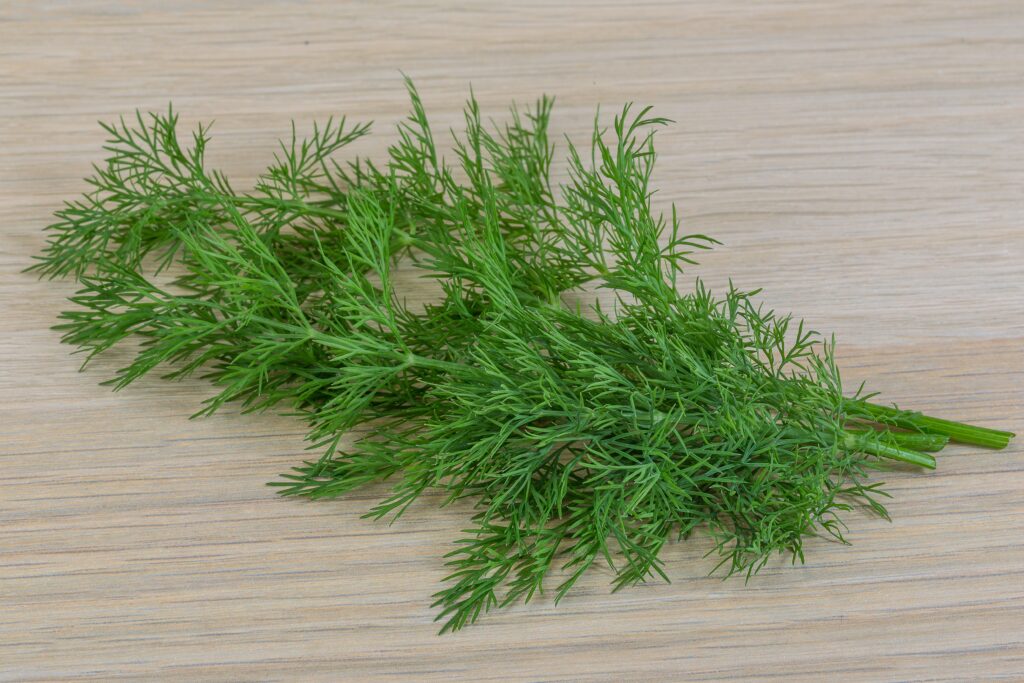
Dill leaf farming has emerged as a profitable venture for small and medium-scale farmers due to its low input requirements and high market demand. The Dill Leaf Farming Profit Per Acre analysis shows that with a total investment of NRs. 38,000 and a gross income of NRs. 100,000 from 5,000 kg of fresh leaves sold at NRs. 20 per kg, farmers can earn a net profit of NRs. 62,000 per acre.
This represents a profit margin of 62% and a benefit-cost ratio (BCR) of 2.63, meaning that for every rupee invested, the farmer gains approximately 2.63 rupees, highlighting the strong profitability of dill leaf cultivation.
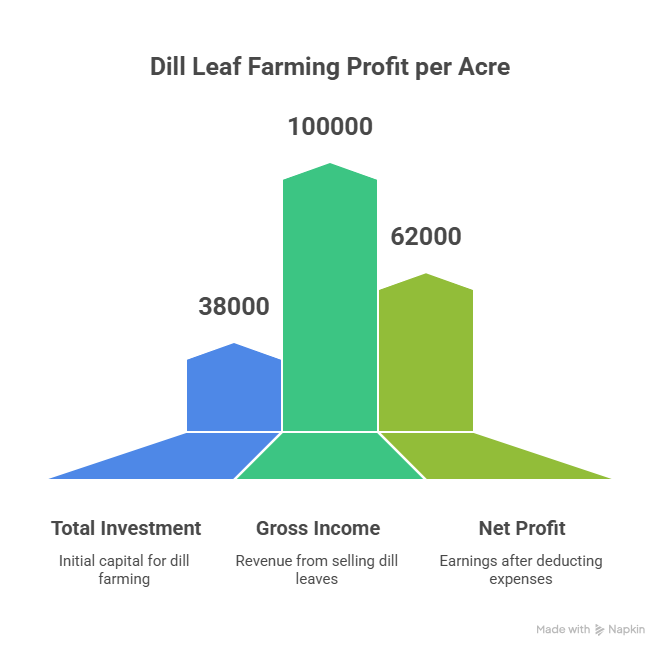
Land Preparation
Preparing land for dill cultivation involves developing a soft, well-aerated, and clean soil surface that supports uniform seed germination and vigorous seedling growth. The process typically starts with deep plowing—around 15 to 20 centimeters—using a moldboard or disc plow to loosen compact soil layers, enhance air movement, and mix in any remaining crop debris.
After this, the soil is usually exposed to sunlight for several days to help suppress weed seeds and soil-borne diseases. Secondary tillage is then carried out using a cultivator or rotavator two to three times, breaking down large soil clods and achieving a fine tilth suitable for sowing.
Finally, the field is leveled evenly with a plank or laser leveler to facilitate uniform irrigation. In heavy or water-retentive soils, raised beds are often created to improve drainage and reduce the risk of waterlogging during rainfall.
Soil Type
Dill thrives in loose, fertile soils with good drainage, particularly those with a loamy or sandy-loam texture enriched with organic matter. Because the plant does not tolerate standing water, poorly drained fields often lead to root decay and fungal infections. For optimal growth, the soil should maintain a pH between 5.5 and 7.0, offering a slightly acidic to neutral environment that supports healthy root and foliage development.
Climatic Requirements
Dill prefers a cool and moderately warm climate, growing best when daytime temperatures stay between 15°C and 25°C (59°F–77°F). Prolonged exposure to heat above 30°C (86°F) often leads to early flowering, which reduces leaf yield and quality.
Although young plants can tolerate mild frost, intense cold can harm their tender tissues. To ensure vigorous growth and optimal essential oil production, dill should be cultivated in open fields where it receives a minimum of six to eight hours of direct sunlight each day.
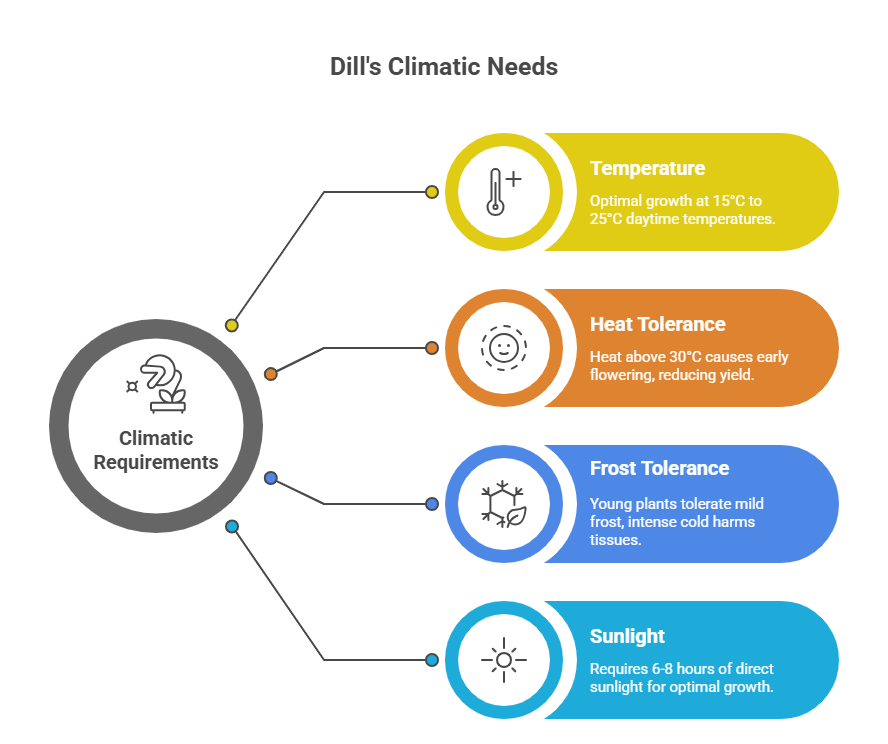
Major Cultivars
| Cultivar | Key Characteristics |
| Bouquet | A common variety known for its vigorous growth and high leaf yield. |
| Fernleaf | A compact, slow-bolting cultivar ideal for leaf production and container gardening. |
| Dukat (Tetra) | Known for its high essential oil content and dark blue-green leaves. |
| Superdukat | An improved version of Dukat with even higher oil content and yield. |
| Local Varieties | Locally adapted strains selected by farmers for performance in specific regional conditions. |
Propagation
Dill is primarily propagated through seeds, which generally have high viability and germinate easily when provided with suitable growing conditions.
Seed Rate per Acre
When cultivating dill primarily for its leaves, approximately 8 to 10 kilograms of seed per acre are typically used. This higher seeding rate, compared with that used for seed production, encourages closer plant spacing, resulting in a thicker canopy and greater foliage yield.
Planting
a). Planting Season
In the plains, dills are mainly sown during October to November for the Rabi season and again in February to March for the spring crop, while in hilly regions, sowing is carried out from March to July to avoid the effects of harsh winter conditions.
b). Planting Direction
Rows are typically laid out in an East-West direction to maximize sunlight interception by all plants.
c). Spacing
When dill is cultivated mainly for harvesting leaves, plants should be spaced more closely to encourage compact growth and higher foliage output. After thinning, a spacing of roughly 30 centimeters between rows and 20 centimeters between individual plants is considered optimal for achieving a dense leaf cover and efficient field use.
d). Planting Method
Drill Sowing
Drill sowing is the preferred and most effective technique for establishing a dill crop. Seeds are placed in shallow furrows about 1–2 centimeters deep, keeping the proper distance between rows and plants. This approach allows for even seed placement, promotes uniform germination, and facilitates field operations such as weeding, irrigation, and nutrient management. As a result, plants grow more vigorously and utilize soil resources more efficiently.
Broadcast Sowing
In this approach, seeds are dispersed evenly over the soil surface of the prepared field. Although it is quicker and requires less labor at planting, it often leads to irregular plant distribution and demands a higher quantity of seed. Moreover, managing weeds and thinning becomes more challenging, which can increase plant competition and ultimately lower yield compared to drill sowing.
e). Number of Plants per Acre
Based on the recommended spacing, a dill crop can accommodate approximately 67,450 plants per acre.
Intercropping
Dill serves as a valuable companion crop and can be effectively grown alongside vegetables like cabbage, onions, lettuce, and cucumbers. Its aromatic foliage attracts predatory insects that help control pests affecting these neighboring plants. However, when producing dill for seed, it should not be intercropped with other members of the Apiaceae family, such as fennel or coriander, because cross-pollination between these related species can reduce the genetic purity of the resulting seed.
Irrigation
Watering for dill should start right after sowing to help the seeds settle into the soil and trigger germination. During this early stage, it’s important to keep the soil evenly moist for about 10 to 14 days, but avoid oversaturation. Once the seedlings have taken root, provide moderate irrigation roughly once every week to ten days, depending on soil moisture and local weather. A drip irrigation system is ideal, as it saves water and minimizes leaf wetness, helping to lower the chance of fungal problems.
Fertilizer and Manure
A soil analysis should be conducted before planting to determine the exact nutrient needs of the crop. While preparing the field, incorporate about 10–15 tonnes of well-decomposed farmyard manure per acre. In addition, apply inorganic fertilizers at approximately 50 kg nitrogen, 40 kg phosphorus (as P₂O₅), and 40 kg potassium (as K₂O) per acre.
The full amounts of phosphorus and potassium, along with half the nitrogen, can be applied before sowing as a base application. The remaining nitrogen—around 25 kg per acre—should be supplied 30 to 35 days after sowing, during vigorous vegetative growth, to support healthy leaf development.
Weed Control
Young dill plants are highly sensitive to weed competition, particularly during the first month to month and a half after sowing. Effective weed control can be achieved through a combination of preventive, mechanical, and chemical approaches.
Preparing a weed-free seedbed before planting minimizes early weed emergence. After sowing, one or two shallow hoeings or light inter-cultivations using a wheel hoe can remove weeds without disturbing the plant’s fine root system; the first operation is best done about three to four weeks after planting.
Where herbicide use is appropriate, a pre-emergence application of Pendimethalin at about 1 kg active ingredient per acre can suppress weed seed germination—always following safety and usage guidelines provided on the product label.
Inter Culture Operation
The primary intercultural practice in dill cultivation is leaf pruning, which serves both as maintenance and harvest. By periodically trimming the older, outer leaves, growers stimulate the development of young, tender foliage from the center of the plant. To sustain vegetative growth, early flower shoots should also be pinched off, preventing the plant from diverting its nutrients and energy into seed formation.
Flowering and Fruit Management
When growing dill for foliage, flowering should be minimized since it redirects the plant’s energy toward seed formation, causing the leaves to become tougher and lose aroma. To prevent this, the main flower stalk—or umbel—should be gently removed as soon as it starts to emerge.
This practice postpones bolting and allows continued production of tender leaves. Selecting slow-bolting cultivars like Fernleaf can further help maintain an extended harvesting phase.
Pest and Disease Management
Major Pests
Aphids
These tiny, soft-bodied pests feed on the sap of dill foliage, causing leaf curling, yellow discoloration, and reduced plant vigor. Severe infestations can lead to noticeable yield and quality losses. To manage them organically, a neem oil spray (2–3 ml per liter of water) can be applied evenly on the plants. If the problem persists, a foliar spray of Imidacloprid at 0.3–0.5 ml per liter of water may be used, preferably during early morning or late evening hours to minimize harm to beneficial insects.
Armyworms and Caterpillars
These leaf-feeding larvae chew holes in the leaves and, in severe cases, can strip entire plants. For light infestations, manually removing the caterpillars works well and avoids chemical use. When populations are higher, the biological pesticide Bacillus thuringiensis (Bt) can be sprayed at 2–3 g per liter of water. This eco-friendly option effectively controls chewing insects without endangering people, livestock, or pollinators.
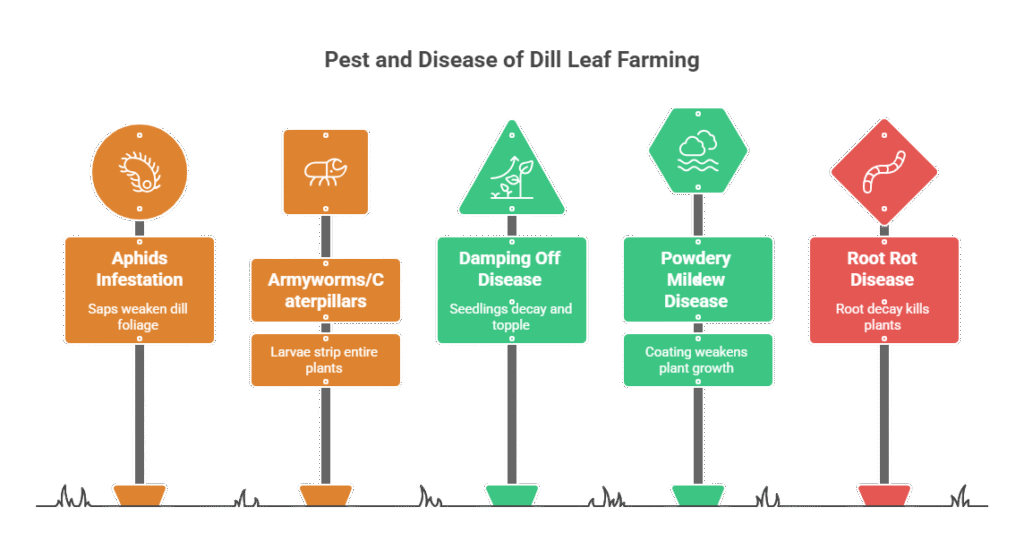
Major Diseases
Damping Off
This fungal disease primarily attacks young seedlings, leading to softening and decay at the stem base, which causes the plants to topple and die. To minimize infection, maintain good soil drainage and avoid excessive watering. Seed treatment with fungicide such as Carbendazim at 2 g per kilogram of seed before sowing, or using pre-treated seed, helps prevent disease onset.
Powdery Mildew
This disease is characterized by a whitish, powder-like coating on the leaves that interferes with photosynthesis and weakens plant growth. Adequate spacing between plants improves air flow and reduces humidity, discouraging the fungus. If symptoms appear, a foliar application of Sulfur (3 g per liter of water) or Dinocap (0.5 ml per liter) can be used, repeating the treatment every 10–15 days when necessary.
Root Rot
Usually triggered by poor drainage or prolonged waterlogging, root rot results in root decay and eventual plant death. Because chemical treatments are largely ineffective, prevention through proper field management is essential. Maintaining well-drained soil and moderating irrigation are the best defenses against this problem.
Harvesting
Harvesting fresh dill leaves can start roughly six to eight weeks after sowing, once the plants are well developed. Tender foliage and young stems should be clipped about 2–5 centimeters above the ground, or the entire plant may be removed when it reaches 15–20 centimeters in height.
When the cut is made above the growing point, plants often regenerate, allowing for a smaller secondary harvest. To retain the best aroma and flavor, it is advisable to harvest during the early morning hours, when essential oil concentration is highest.
Yield
The yield of dill depends largely on the cultivar, climate, and management practices. A well-managed crop can produce 4,000–6,000 kg (4–6 tonnes) of fresh leaves per acre. Considering the drying ratio of approximately 5:1, the corresponding dry leaf yield is expected to be around 800–1,200 kg per acre.
Cost of Investment Per Acre for Dill Leaves
| S.N. | Category | Cost of Investment (NRs.) |
| 1 | Land Preparation | 12,000 |
| 2 | Seed | 1,000 |
| 3 | Seed Sowing | 1,000 |
| 4 | Fertilizers and Manure | 7,000 |
| 5 | Irrigation | 4,000 |
| 6 | Weed Control (pre & post-emergence) | 2,000 |
| 7 | Pest & Disease Control | 2,000 |
| 8 | Harvesting | 4,000 |
| 9 | Miscellaneous Costs | 5,000 |
| Total Cost | 38,000 |
Income Per Acre from Dill Leaves
| Particulars | Estimated Yield / Acre (Kg) | Market Price (NRs./kg) | Total Income (NRs.) |
| Fresh Leaf Yield | 5,000 | 20 | 100,000 |
Analysis of Dill Leaf Farming Profit Per Acre
| Analysis Metric | Calculation (NRs.) | Result (NRs.) |
| A. Gross Income | 5,000 kg × NRs. 20 | 100,000 |
| B. Total Investment Cost | (As per table 1) | 38,000 |
| C. Net Profit | A – B | 62,000 |
| D. Profit Margin | (C / A) × 100 | 62% |
| E. Benefit-Cost Ratio (BCR) | A / B | 2.63 |
The profit analysis of dill leaf farming per acre shows that with a total investment of NRs. 38,000 and a gross income of NRs. 100,000 from 5,000 kg of fresh leaves sold at NRs. 20 per kg, the net profit amounts to NRs. 62,000 per acre. This results in a profit margin of 62% and a benefit-cost ratio (BCR) of 2.63, indicating that for every 1 rupee invested, the farmer earns approximately 2.63 rupees, making dill leaf farming a highly profitable venture.
Crop Calendar of Dill Leaf
| Stage | Period / Timing | Key Activities & Tasks | Objectives & Notes |
| 1. Pre-Planting & Land Preparation | 2-3 weeks before sowing | • Site Selection: Choose a sunny location (at least 6-8 hours of sun). • Soil Testing: Test soil pH and nutrient levels. • Bed Preparation: Clear weeds and debris. Plough/harrow to a fine tilth. • Amendments: Incorporate well-decomposed compost or manure (e.g., 10-15 tons/hectare). | To create a fertile, well-draining, and weed-free seedbed. Dill has a taproot, so loose soil is crucial. |
| 2. Sowing / Planting | Spring Crop: After last frost date. Fall Crop: 6-8 weeks before first fall frost. Tropical Climates: In the cool, dry season. | • Method: Direct seeding is highly preferred (transplanting can stunt growth). • Spacing: Sow seeds ¼ to ½ inch deep, in rows 12-18 inches apart. Thin seedlings to 4-6 inches apart within the row. • Seeding Rate: ~ 8-10 kg/hectare. | Ensure good seed-to-soil contact. Keep the seedbed consistently moist until germination, which takes 10-14 days. |
| 3. Vegetative Growth Stage | Weeks 1 to 6 after germination | • Thinning: Thin seedlings to the recommended spacing when they are 2 inches tall. • Weeding: Weed carefully by hand; dill roots are shallow. • Irrigation: Water regularly to keep soil moist but not waterlogged. Drip irrigation is ideal. • Fertilization (Side-dressing): If needed, apply a light, balanced fertilizer (like 10-10-10) 4-6 weeks after sowing. | Promote the development of strong, leafy growth. Avoid water stress, which can trigger early bolting. |
| 4. Harvesting | First Harvest: ~ 6-8 weeks after sowing. Subsequent Harvests: As needed until bolting. | • Method: Snip leaves or the top 1/3 of the plant with clean scissors or shears, leaving enough foliage for the plant to recover. • Timing: Harvest in the cool of the morning for the best flavor and aroma. • For a Single Harvest: Cut the entire plant at the soil level before the flower umbels form. | Maximize yield and quality of the essential oils. Regular harvesting delays flowering. |
| 5. Post-Harvest & Seed Saving (Optional) | After final harvest | • Handling: Use immediately, refrigerate (in a plastic bag), or process. • Drying: Hang bunches upside down in a warm, dry, dark, well-ventilated area. • Freezing: Freeze chopped dill in ice cube trays with water or oil. • Seed Saving: Allow some healthy plants to flower and set seed. Harvest seed heads when brown and dry. | Proper handling preserves the volatile oils that give dill its flavor and aroma. |
Sources
Food and Agriculture Organization (FAO)
University of California Agriculture & Natural Resources (UC ANR)
European Plant Protection Organization (EPPO)
Punjab Agricultural University (PAU)
Tamil Nadu Agriculture University (TNAU) – Agritech portal
Indian Council of Agricultural Research (ICAR)
Nepal Agricultural Research Council (NARC)
U.S. Department of Agriculture (USDA).
Ministry of Agriculture and Livestock Development (Nepal)
Disclaimer: This crop farming profits assume optimal conditions. Actual results may vary depending on climate, market prices, and farm management practices.
